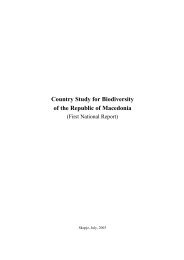CBD Fourth National Report - Azerbaijan (English version)
CBD Fourth National Report - Azerbaijan (English version)
CBD Fourth National Report - Azerbaijan (English version)
Create successful ePaper yourself
Turn your PDF publications into a flip-book with our unique Google optimized e-Paper software.
Country Study on Biodiversity and <strong>Fourth</strong> <strong>National</strong> <strong>Report</strong><br />
The Republic of <strong>Azerbaijan</strong><br />
• State-owned Varvara reservoir is situated on the Kura River, to the south-east of<br />
Mingachevir and covers 2,140 ha. The reservoir supports a high diversity of zooplankton,<br />
algae, phytoplankton, and higher plants. Of the 34 species of fish found in the lake, 16 are<br />
considered economically important.<br />
• Jhandargol Lake is situated on the border with Georgia and covers 1,250 ha. Its water is<br />
used for irrigation, and the lake supports an important fishing industry. The lake is rich in<br />
biodiversity, including four globally threatened bird species 5 , and an important reed bed<br />
community.<br />
There are many wetlands and water bodies in Nakhichevan Autonomous Republic, which<br />
support varied hydrophytic vegetation (nearly 210 species or water, wetland or marshland<br />
plants have been recorded). Although water plants have not been well described in the<br />
Republic, they include duckweeds (Lemna spp.) and pondweeds (Potamogeton spp.). Other<br />
species are more associated with water margins and marshes 6 In general cover and<br />
productivity in these wetland and marshland systems is low.<br />
Coastal and Marine Ecosystems<br />
Picture<br />
The Caspian Sea is the largest enclosed body of<br />
water in the world, covering 436,000 km 2 , with<br />
borders on five countries 7 . The surface of the<br />
Caspian is at 27 m below the level of the world’s<br />
oceans, although historically the level fluctuates.<br />
The deepest point is 1,023 m (the Lenkoran hollow),<br />
but the average depth is just 184 m.<br />
In general the water of the sea is not fresh, but<br />
brackish, (three times less concentrated than the oceans). The Caspian Sea is not a<br />
homogenous water body due to the influx of water with different compositions in different<br />
areas. In general the north Caspian is less salty (due to the influx of water from the Volga and<br />
Ural rivers), and more species diverse than the middle or southern areas. However, nearly all<br />
of the indigenous species are found in the middle of the Caspian where the water composition<br />
is stable.<br />
The Caspian provides a characteristic ecosystem that differs from the major oceans of the<br />
world. The sea is of global importance due to the high biodiversity, large number of endemic<br />
species (see Table 3.2), and the presence of globally threatened bird and fish species,<br />
including the economically important sturgeon. The region is also a migration route for<br />
millions of birds moving from Africa and the Mediterranean to Central Asia and India. To<br />
date 446 bird species have been recorded in the Caspian, of which 120 species breed, 62<br />
species over-winter, and 278 species migrate through.<br />
Table 3.2 Number of endemic species found in the Caspian<br />
Phylum Subphylum Class Subclass Order Number of<br />
endemics<br />
5 Lesser white-fronted goose (Anser erythropus), pygmy cormorant (Phalacrocorax pygmaeus), Dalmatian<br />
pelican (Pelecanus crispis) and imperial eagle (Aquila heliaca).<br />
6 For example, Convolvulus persicus, Heliotropium ellipticum, Halacnemum strabilaceum, Salicornia<br />
europaea, Puccinellia qiqanteae, and Chenopodium rubrum<br />
7 Russian Federation, Republic of Kazakhstan, Republic of <strong>Azerbaijan</strong>, Republic of Turkmenistan and<br />
Islamic Republic of Iran.<br />
29<br />
2009

















